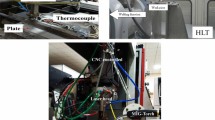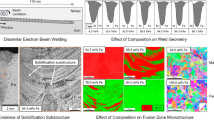Abstract
Variations in laser beam welding parameters can significantly influence weld pool shape and microstructure formation in stainless steel (SS) alloys. Fusion zone development using high travel speeds and low overall heat input promotes rapid solidification and high cooling rates. The difference in solidification rate within the weld pool is strongly influenced by changes in the weld pool geometry, which is directly dependent on process parameters. Therefore, a complete understanding of weld pool geometry as a function of process conditions is crucial to predicting solidification phenomena and avoiding weldability-related issues such as solidification cracking or an undesirable ferrite/austenite phase balance. In this work, the effect of laser weld parameters on the transition from conduction to keyhole mode welding was determined and related to microstructure formation in six SS alloys. The alloys had WRC-1992 Creq/Nieq ratios ranging from 1.7 to 2.8. The 1.7 Creq/Nieq alloy was a commercially available 304L SS, while the 2.7 Creq/Nieq was a 2205 duplex stainless steel. Compositions were also tested between these extremes. Both transverse and longitudinal view sections were evaluated to determine solidification behavior and phase fractions. Electron backscatter diffraction patterns were used extensively to determine phase fractions. Relationships among penetration mode (conduction vs. keyhole), composition (Creq/Nieq), and microstructure (solidification mode and phase fraction) are presented and compared to rapid weld solidification diagrams from the literature. The results presented here provide a more complete picture of rapid solidification phenomena associated with laser welds in SS alloys over a wide range of compositions.















Similar content being viewed by others
References
American Welding Society (2007) Laser beam welding, cutting, and associated processes. In: Welding Handbook Volume 3 Welding Processes, Part 2, Kautz D, Merchant VE, Milewski JO, Powers DE (eds), 9th edn. American Welding Society, Miami, 503–560
Patterson T, Hochanadel J, Sutton S, Panton B, Lippold J (2021) A review of high energy density beam processes for welding and additive manufacturing applications. Weld World 65(7):1235–1306. https://doi.org/10.1007/s40194-021-01116-0
Lippold JC (1985) Centerline cracking in deep penetration electron beam welds in type 304L stainless steel. Weld J 64(5):127s-136s
Vitek JM, Dasgupta A, David SA (1983) Microstructural modification of austenitic stainless steels by rapid solidification. Metall Trans A Phys Metall Mater Sci 14 A(9):1833–1841
David SA, Vitek JM (1989) Correlation between solidification parameters and weld microstructures. Int Mater Rev 34(1):213–245. https://doi.org/10.1179/imr.1989.34.1.213
V. C. Kreuter V, Lippold JC (2016) Ductility-dip cracking susceptibility of commercially pure Ni and Ni-base alloys utilizing the strain-to-fracture test. In: Cracking Phenomena in Welds IV. (eds) Thomas Bollinghaus, J. C. Lippold and C. E. Cross, Springer, 145–159
Lienert TJ, Lippold JC (2003) Improved weldability diagram for pulsed laser welded austenitic stainless steels. Sci Technol Weld Join 8(1):1–9. https://doi.org/10.1179/136217103225008847
Baeslack WA, Davis JR, Cross CE (1993) Selection and weldability of conventional titanium alloys. In: ASM Handbook, Volume 6: Welding, Brazing, and Soldering, (eds) Olson DL, Siewert TA, Liu S, Edwards GR, vol 6. ASM International, 507–523
Baeslack WA III, Becker DW, Froes FH (1984) Advances in titanium alloy welding metallurgy. J Met 36(5):46–58. https://doi.org/10.1039/c2ay25041a
Varol I, Lippold JC, Baeslack WA (1992) Welding of duplex stainless steels. Key Eng. Mater 69-70:217–252
Lippold JC, Kotecki DJ (2005) Welding metallurgy and weldability of stainless steels. John Wiley & Sons, Inc
Baghdadchi A, Hosseini VA, Hurtig K, Karlsson L (2021) Promoting austenite formation in laser welding of duplex stainless steel—impact of shielding gas and laser reheating. Weld World 65(3):499–511. https://doi.org/10.1007/s40194-020-01026-7
Omura T, Kushida T, Komizo Y (2000) Microstructural features and corrosion properties in laser welded duplex stainless steels. Weld Int 14(4):257–260. https://doi.org/10.1080/09507110009549176
Karlsson L (2012) Welding duplex stainless steels - a review of current recommendations. Weld World 56(5–6):65–76. https://doi.org/10.5937/zzk1802065k
Berger J (2018) Effect of preferential vaporization during laser rewelding on the solidification and cracking response of type 304L stainless steel alloys with systematically varied manganese contents, Masters Thesis, The Ohio State University
Lippold JC (1994) Solidification behavior and cracking susceptibility of pulsed-laser welds in austenitic stainless steels. Weld J 73(6):129s–139s
Elmer JW, Allen SM, Eagar TW (1989) Microstructural development during solidification of stainless steel alloys. Metall Mater Trans A 20, 2117–2131. https://doi.org/10.1007/BF02650298
Suutala N (1983) Effect of solidification conditions on the solidification mode in austenitic stainless steels. Metall Trans A 14:191–197. https://doi.org/10.1007/BF02651615
Muthupandi V, Bala Srinivasan P, Seshadri SK, Sundaresan S (2003) Effect of weld metal chemistry and heat input on the structure and properties of duplex stainless steel welds. Mater Sci Eng A 358(1–2):9–16. https://doi.org/10.1016/S0921-5093(03)00077-7
Taban E, Kaluc E (2011) Welding behaviour of duplex and superduplex stainless steels using laser and plasma arc welding processes. Weld World 55(7–8):48–57. https://doi.org/10.1007/BF03321307
Keskitalo M, Mäntyjärvi K, Sundqvist J, Powell J, Kaplan AFH (2015) Laser welding of duplex stainless steel with nitrogen as shielding gas. J Mater Process Technol 216:381–384. https://doi.org/10.1016/j.jmatprotec.2014.10.004
Nakao Y, Nishimoto K, Zhang WP (1988) Effects of rapid solidification by laser surface melting on solidification modes and microstructures of stainless steels. Trans Japan Weld Soc 19(2): 20–26
David SA, Vitek JM, Boatner LA, Rappaz M (1995) Application of single crystals to achieve quantitative understanding of weld microstructures. Mater Sci Technol 11(9):939–948. https://doi.org/10.1179/mst.1995.11.9.939
David SA, Vitek JM, Babu SS, Boatner LA, Reed RW (1997) Welding of nickel base superalloy single crystals. Sci Technol Weld Join 2(2):79–88. https://doi.org/10.1179/stw.1997.2.2.79
Rappaz M, David SA, Vitek JM, Boatner LA (1989) Development of microstructures in Fe-15Ni-15Cr single crystal electron beam welds. Metall Trans A 20:1125–1138. https://doi.org/10.1007/BF02650147
Rappaz M, David SA, Vitek JM, Boatner LA (1990) Analysis of solidification microstructures in Fe-Ni-Cr single-crystal welds. Metall Trans A 21:1767–1782. https://doi.org/10.1007/BF02672593
Kou Sindo (2003) Welding Metallurgy, 2nd edn. John Wiley & Sons Inc, Hoboken
Patterson T (2021) Understanding weld formation and microstructure evolution in laser welded stainless steels and Ti-6Al-4V, PhD Dissertation, The Ohio State University
PRIMES GmbH, FocusMonitor FM+, https://www.primes.de/en/products/beam-distribution/focus-measurement/focusmonitor-fmplus.html (accessed Nov. 02, 2021)
International Standards Organization, ISO 11146–1:2005 Lasers and laser-related equipment – test methods for laser beam widths, divergence angles and beam propagation ratios – part1: stigmatic and simple astigmatic beams. International Standards Organization, 2005
ASTM E1019–11: standard test methods for determination of carbon, sulfur, nitrogen, and oxygen in steel and in steel, iron, nickel, and cobalt alloys by various combustion and fusion techniques. West Conshohocken, PA, United States: ASTM International, 2011
Kujanpää V, Suutala N, Takalo T, Moisio T (1979) Correlation between solidification cracking and microstructure in austenitic and austenitic-ferritic stainless steel welds. Weld Res Int 9(2):55–75
Hammar O, Svennson U (1979) Influence of steel composition on segregation and microstructure during solidification of austenitic stainless steels. Solidif Cast Met 192: 401–410
Knyazeva M, Pohl M (2013) Duplex steels. Part II: carbides and nitrides. Metallogr Microstruct Anal 2(5):343–351. https://doi.org/10.1007/s13632-013-0088-2
Rodelas JM, Maguire MC, Michael JR (2014) Deformation‐induced martensite formation in austenitic stainless steel welds. Sandia National Laboratories, Albuquerque, NM, USA. https://www.osti.gov/servlets/purl/1115084 (accessed Nov. 02, 2021)
Kotecki DJ, Siewert TA (1992) WRC-1992 Constitution diagram for stainless steel weld metals: a modification of the WRC-1988 diagram. Weld J 71(5):171s–178s
Acknowledgements
The authors thank Los Alamos National Laboratory (LANL) for providing financial support and recognize the contributions of Dr. Matt Johnson and Dr. David Tung who served as the LANL mentors for this project. Also, the authors thank IPG Photonics®, specifically, Kevin Arnold and the Midwest Operations group for their support of OSU’s high-power laser lab.
Electron microscopy was performed at the Center for Electron Microscopy and Analysis (CEMAS) at the Ohio State University.
Funding
This research was supported through the National Science Foundation (NSF) sponsored Industry/University Cooperative Research Center (I/UCRC): Manufacturing and Materials Joining Innovation Center (MA2JIC) under grant number 1822144.
Author information
Authors and Affiliations
Corresponding author
Ethics declarations
Conflict of interest
The authors declare no competing interests.
Additional information
Publisher's note
Springer Nature remains neutral with regard to jurisdictional claims in published maps and institutional affiliations.
Recommended for publication by Commission IX - Behaviour of Metals Subjected to Welding
Appendix
Appendix
Suutala Creq/Nieq equivalency formula [32]
Hammar and Svennson Creq/Nieq equivalency formula [33]
WRC-1992 Creq/Nieq equivalency formula [36]
Comparison of ferrite content and grain size in the same heat of 304L (a) and M58 (b) with a HV1.0 hardness indent showing no indication of deformation-induced martensite. The 304L section contained a very high amount of ferrite. A comparison to the same heat at another location is shown in Fig. 18
Rights and permissions
About this article
Cite this article
Patterson, T., Lippold, J. & Panton, B. Laser weld formation and microstructure evolution in stainless steel alloys. Weld World 66, 1521–1534 (2022). https://doi.org/10.1007/s40194-022-01285-6
Received:
Accepted:
Published:
Issue Date:
DOI: https://doi.org/10.1007/s40194-022-01285-6







